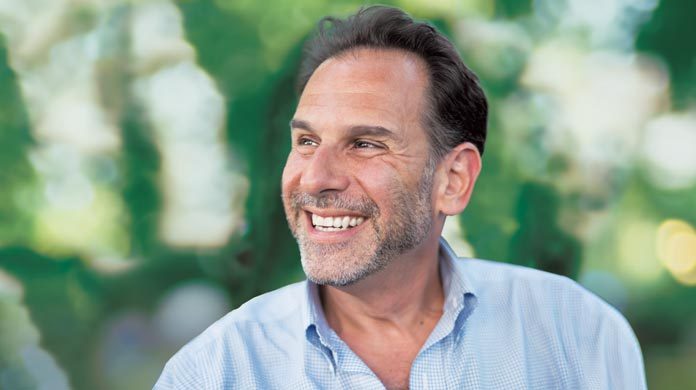
It’s crazy to think that culinary author Andrew Friedman found his calling by accident. While working in a PR firm after college (where he was an English major at Columbia), Friedman started to work with rising chefs at the time and sort of fell in love with the culinary niche. With a passion for writing (he originally wanted to be a screenwriter), he was able to ghostwrite for a number of his culinary clients, finally landing an opportunity of a lifetime with Alfred Portale.
After several different books throughout the years, his latest effort, Chefs, Drugs and Rock & Roll, sheds light on how American chefs become a celebrity profession, providing an all-access history of the evolution of the American restaurant chef from the 1970s to present day. Industry professionals will appreciate the unique insight. Total Food Service had the opportunity to talk to Andrew Friedman about his interests, the book and more.
How did your interest in chefs and the culinary world come about?
I met Alfred Portale, who was one of my PR clients. And as soon as I started to get involved with the chef and restaurant world I absolutely loved it. I guess it’s sort of an opposites attract thing the complete polar opposite of the stereotypical chef. I was a college graduate and I just started to become friends with all the guys in the culinary world. I loved hanging out with them and loved being around the restaurants.
Because of my writing background, I did a lot of ghostwriting for clients to help with speeches, letters or whatever they needed and then I ended up doing Alfred Portale’s Gotham Bar and Grill Cookbook in 1997. He was still my client and I thought it would be sort of a onetime lark to be honest. And that book did really well, and I thought it wasn’t the kind of writing I wanted to do, but maybe it’s at least a way to be a working writer. I vividly remember we basically taught ourselves how to write a cookbook. I knew I loved restaurants and eating well. I wasn’t at home cooking, either. I didn’t really know much about food.
So what has happened between the Portale project and where you are today?
I collaborated on 30 plus cookbooks and then gradually started migrating toward more memoir projects. I hate writing recipes. And you know I had sort of a revelation almost 10 years ago amazingly I did a book called Knives at Dawn: America’s Quest for Culinary Glory at the Legendary Bocuse D’Or Competition. I would sit and interview all these cooks and chefs who I didn’t know (because I knew everyone in New York already) and I realized I really understood their world. I had been hearing stories from Alfred and the like about the culinary world and at some point I started referring to myself as a chef writer and not a food writer.
How did this book Chefs, Drugs and Rock & Roll come about?
I didn’t feel like anyone had ever written the story of the birth of this profession in the United States. There have been books about the food, but not really the chefs despite only memoirs. There wasn’t really a story about the rise of the chef in America as being an influential figure. Sure there have been individual memoirs. But what I saw were books that were either very personal memoirs or very West Coast biased books that reflected the world according to Anthony Bourdain. I also had some books that had profiled other disciplines including music and business. My favorite was a book titled: Easy Riders, Raging Bulls. It was a profile of the great American film directors of the 70’s who reinvented Hollywood. There was a second book: Please Kill Me: An Oral History of Punk Rock and Live from New York that profiled Saturday Night Live. It came full circle when the Wall Street Journal reviewed my book and compared it to one of those. And these parallel worlds come together when I shared a story in my book about the actor Dudley Moore investing in a restaurant and on the emergence of chefs into our culture.
You mention in the book that changes in French cuisine had a major impact on the evolution of dining in the U.S.
It’s funny that from the 20’s until the 70’s that you couldn’t even call the culinary arts and being a chef glamorous. You started to see the creation of nouvelle cuisine and France and then as Americans were travelling the world, many of these chefs started to appear on magazine covers. That set the tone for what happened here as great French restaurants found their way to major American cities. But it’s interesting what happened. Because all of these chefs were cooking out of the Escoffier cookbook, the menus were basically interchangeable.
So where did the creativity come from in New York and the US?
All of a sudden chefs like Paul Prudhomme began doing blackened redfish. Wolfgang Puck created a buzz with unbelievable accessible dishes that broke the traditional French mold at Spago. Jeremiah Tower and his team proved that you could change a menu every day. In New York, chefs including Larry Forgione began producing their own take on regional American fare with a nod to classic technique.
There are many that think it was television that ultimately brought us to this golden age of American chefs.
It’s crazy but now you can finish fourth or fifth in a food competition on TV, become famous and most importantly raise the money to open a restaurant. So what happened was in the 70’s you had to be a great chef to become famous. Not today.
I had a very unique perspective early on as a publicist during the launch of the Food Network. I’m even old enough to remember when the New York Times expanded their weekly Dining section. The truth is that their real game change has been the emergence of You Tube. Do you want to make pastry, need to know how to spin sugar; it’s all there on You Tube.
Do you believe it’s essential to go to a culinary school to become a great chef?
I don’t believe it’s an essential thing. I do believe that even if you do go to cooking school that you’ll learn, but it really doesn’t prepare you for the rigors of the daily kitchen life. To me it’s the difference between training in a flight simulator or actually flying a plane. It’s way more about the externship experience to supplement what you are doing in the classroom. You need to know if this is really for you.
There are now too many people coming out of culinary school. They are split into two categories: those in a hurry who want to open their restaurant by the time they are 30 and those looking to work at some sort of Michelin-level restaurant. These people have more of an old school mentality of taking their time to perfect their skills, while the others are more in a hurry.
What made you decide to attend classes at the French Culinary?
I just thought that if I was going to write about the industry that the basic rudimentary skills would be very helpful. So I enrolled in Saturdays only program that was six hours a day. I was hoping that it would give me a common frame of reference with the chefs I was working with. It was a great experience; I avoided all of the hot shots in the class and found the oldest guy to partner with.
Can you talk about how Chefs, Drugs and Rock and Roll, outlined the differences between the East and West Coast restaurant scenes?
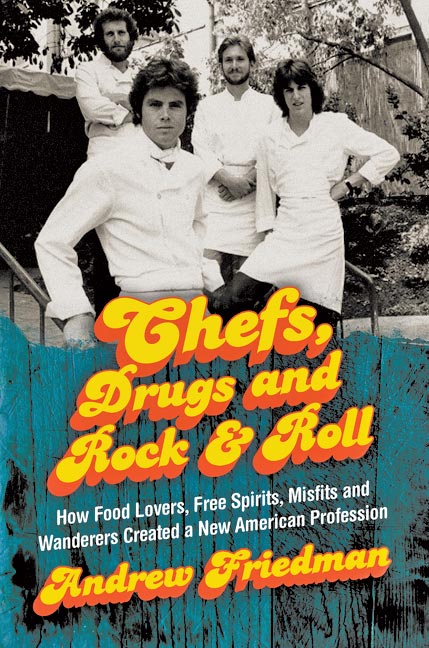 The Bay Area/Berkeley scene was all about the hippie chef. The UC Berkley grad student drops out or a graduate who’s not ready for law school. They turned to food as part of their protest culture and they know that the Free Speech Movement started at UC Berkley. They travelled in France, and came back with French menus written in French that featured fairly traditional cuisine. They didn’t go to cooking school and had no formal training. They certainly were not obsessed with technique. What’s really interesting and in many ways ahead of its time was that the Northern California/Berkley scene was dominated by female chefs and restaurateurs. Alice Waters at Chez Panisse, Judy Rogers who opened in Napa and Cindy Paulson and Deb Madison all led the way.
The Bay Area/Berkeley scene was all about the hippie chef. The UC Berkley grad student drops out or a graduate who’s not ready for law school. They turned to food as part of their protest culture and they know that the Free Speech Movement started at UC Berkley. They travelled in France, and came back with French menus written in French that featured fairly traditional cuisine. They didn’t go to cooking school and had no formal training. They certainly were not obsessed with technique. What’s really interesting and in many ways ahead of its time was that the Northern California/Berkley scene was dominated by female chefs and restaurateurs. Alice Waters at Chez Panisse, Judy Rogers who opened in Napa and Cindy Paulson and Deb Madison all led the way.
The Southern California and LA scene was driven by people like Bruce Marder who Ruth Reichl said in my book created California cuisine. There were talents including John Sedlar and Wolfgang Puck. The famous architect Frang Gehry then designed a contemporary Mexican restaurant in Venice. You would find everything from interpretations of Mexican street food to an India inspired Samosa. What the LA culinary scene was all about in the 70’s and early 80’s was international eclecticism. Later on the glitz of Hollywood had its impact on the LA culinary scene.
So as you did your research what made New York unique?
Guys like Charlie Palmer, Rick Moonen, Terrence Brennan and Jonathan Waxman. I describe them as accidental chefs. They were kids who did not do well in school and a lot of them were jocks. They got high school jobs as dishwashers and almost accidentally discovered the kitchen and became great cooks. All those guys wanted to do was to please the French and European chefs they worked for. A number of them went to the CIA and were among the first chefs to train in Europe before launching their careers in New York.
The second group that made such an impact in New York that I profile in the book were what I call the “Five Couples”. They all opened their restaurants in New York City in 1979. Karen and David Waltuck had Chantarelle, The Quilted Giraffe’s Susan and Barry Wine, Karen and Bobby Pritzker’s Dodin Bouffant Susan and David Liederman of Manhattan Market which gave us David’s Cookies and Hubert’s Len and Karen Allison launched a very special era. Fascinating as well that nine of the ten were Jewish. The next wave came when the rents rose in Soho and the Waltucks moved their restaurant to Tribeca and were followed by an untrained chef named Drew Nieporent. In many ways the culinary scene in Soho and the Village was like what was going on in Berkley years before Brooklyn was reborn.
How has social media impacted where the industry is today?
It’s interesting in 1981; there might have been a half dozen new restaurants to try. Today, I was on Eater and there are 30 new restaurants suggested for Spring. So social media is a perfect way to share that story. In addition, there simply is no loyalty anymore between customers and where they eat. There’s no question that Instagram has alot to do with that.
Chefs, Drugs and Rock and Roll talks about how restaurants get financed.
In talking to the Red Cat’s Jimmy Bradley for the book, he told me that he’d rather have a ton of investors. He sees everyone of them as brand ambassadors for the restaurant. Jimmy thinks it’s easier to get five figures from 20 plus investors than six figures from two or three.
You’ve had the opportunity to collaborate with many of the industry’s most successful chefs and restaurateurs. What are the common characteristics that you see?
The most successful ones find what truly makes them tick. When I first met Alfred Portale, 20 plus years ago I knew that he was at peace with exactly where he was. The next thing I see is that you need to set your own agenda for understanding what your limitations are for growth. Some of the most successful ones have built great businesses with multiple concepts in just one City. The great ones also understand what they do well and bring in the right people to build their team. It’s like a great menu, even if it’s eclectic to the eye, it works beautifully.
To learn more about Andrew Friedman, visit his webpage.


















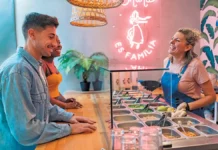
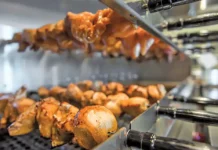
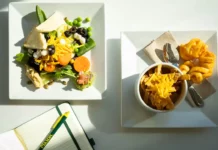

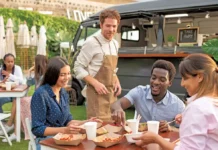

Comments are closed.